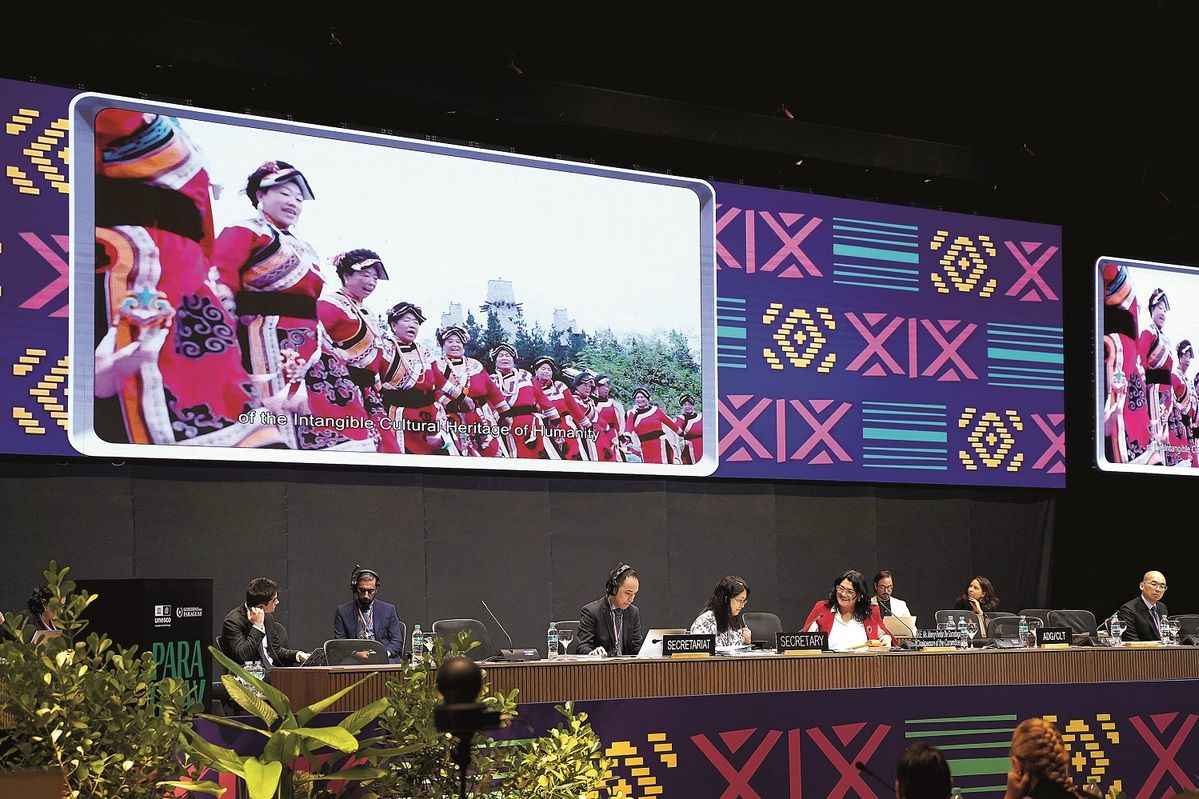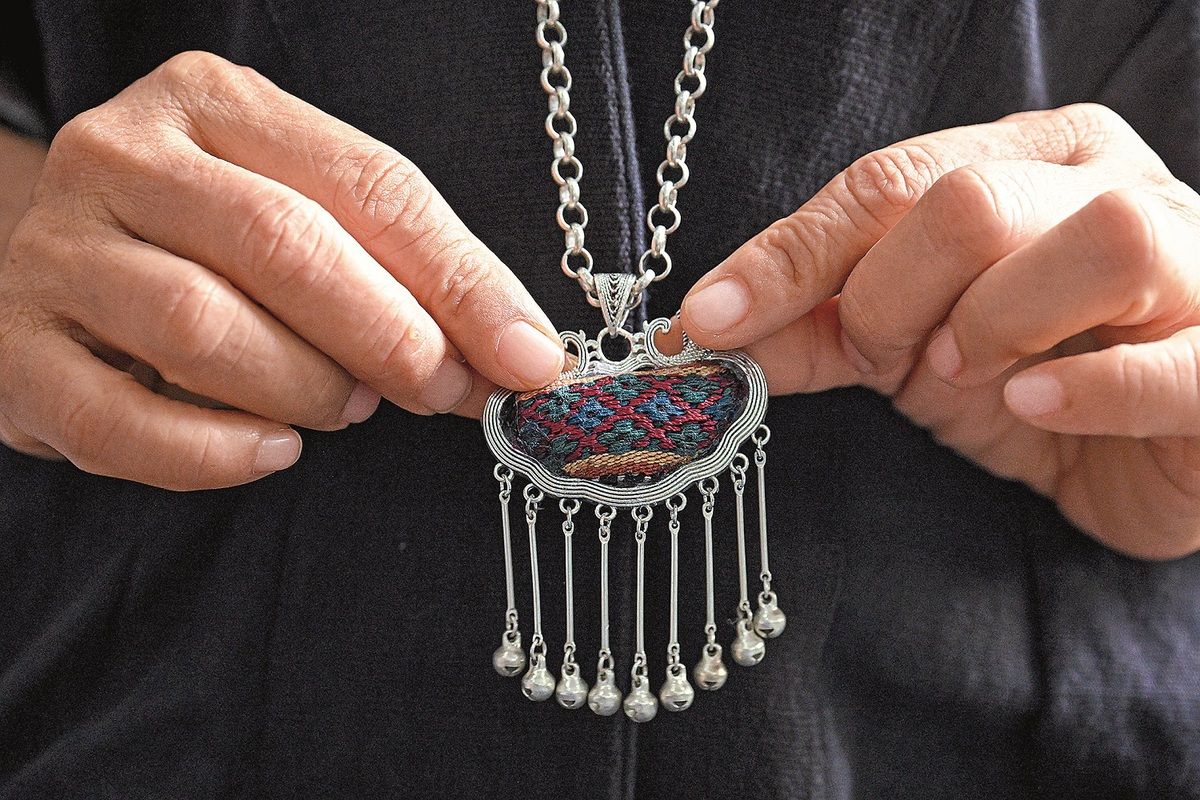Three Chinese items added to UNESCO heritage list
来源:CHINA DAILY 2024-12-07 17:09

A video showing the Qiang New Year festival, a traditional annual event of the Qiang ethnic group in China, is displayed during the 19th session of the Intergovernmental Committee for the Safeguarding of the Intangible Cultural Heritage in Asuncion, Paraguay. The festive event has been included on the UNESCO-endorsed Representative List of the Intangible Cultural Heritage of Humanity. ZHU YUBO/XINHUA
In a remarkable display of conservation success, China's dedicated efforts have revitalized and safeguarded three endangered cultural treasures, leading to their inclusion on the UNESCO-endorsed Representative List of the Intangible Cultural Heritage of Humanity.
The three items — the Li ethnic group's traditional textile techniques of spinning, dyeing, weaving and embroidering; the Qiang New Year festival, a traditional annual event of the Qiang ethnic group in China; and traditional design and practices for building Chinese wooden arch bridges — have all been elevated to this prestigious status.
The decision was reached on Thursday during the 19th session of the Intergovernmental Committee for the Safeguarding of the Intangible Cultural Heritage in Asuncion, Paraguay.
Previously listed as Intangible Cultural Heritage in Need of Urgent Safeguarding in 2009 due to the looming threat to their survival, these cultural gems have now been rescued and restored to ensure their continued existence.
"The transition means China has achieved significant progress in the protection of intangible cultural heritage and collected precious experience," Pan Lusheng, vice-president of the China Federation of Literary and Art Circles, was quoted as saying by Shanghai-based news portal ThePaper.cn.
"It signifies the number of inheritors has reached a certain scale, and the once nearly extinct skills or practices can now be naturally passed down and developed," he added.

A Chinese wooden arch bridge in Wenzhou, Zhejiang province. ZHANG GUILAN/FOR CHINA DAILY
Zhong Xiaobo, director of the Wenzhou Covered Bridge Culture Society in Zhejiang province, who has devoted over two decades to preserving wooden arch bridges, expressed immense excitement upon hearing the news.
He said that since around 2004, when these bridges were on the brink of extinction, the local people initiated efforts in Taishun county, Zhejiang, to rediscover and support inheritors in revitalizing this craft."This recognition validates our years of hard work," Zhong added.
The wooden arch bridges are mainly found in northern Fujian and southern Zhejiang. Built out of interlocking short beams with wooden sunmao (mortise-and-tenon) joints to create an especially stable arch without nails or rivets, these bridges are the crystallization of the wisdom of people in the mountainous areas of the two provinces, said Lu Zeqi, an expert in cultural heritage in Pingnan county, Fujian, where such bridges are often seen.
The Qiang New Year festival, celebrated in Sichuan province, often takes place on the first day of the tenth lunar month, during which Qiang people gather to hold ceremonies, pay tribute to deities, celebrate the harvest and pray for blessings in festive attire.
In 2008, when the devastating 8.0-magnitude Wenchuan earthquake hit many places where Qiang people live in Sichuan, quite a number of Qiang villages were destroyed and many inheritors passed away, putting at grave risk the tradition, which is only passed on by word of mouth and face-to-face teaching.
Since then, governments at all levels have issued policies and regulations to protect and popularize the festival, while traditional Qiang villages have been restored and their infrastructure has improved.

A Li ethnic woman displays a pendant made with traditional Li textile techniques in Dongfang, Hainan province. PU XIAOXU/XINHUA
"The item's inclusion in the UNESCO list showcases the close attention the Chinese government and society have paid to vulnerable intangible cultural heritage. It also tells us that as long as we are dedicated to protection, we can save even very endangered items," said Yuan Li, a researcher at the Chinese National Academy of Arts specializing in studies of China's intangible cultural heritage.
The endangered traditional textile techniques of the Li ethnic group in Hainan province faced a crisis over a dozen years ago due to low market demand and its limited passing on by word of mouth among females. Yuan noted that with the involvement of male inheritors, product promotion, and modern integration, the craft is experiencing a revival.
UNESCO's documentation said that in the absence of a written language, the patterns on textiles record the history and legends of Li culture as well as aspects of worship, taboos, beliefs, traditions and folkways. These are therefore an indispensable part of the cultural heritage of the Li ethnic group, allowing communities to strengthen their shared historical memory and cultural identity.
Pan said the addition of these items is hoped to bolster the inheritors' sense of mission, encouraging them to promote understanding of their skills and practices, thereby fostering a more conducive environment for the items' future growth.
Peng Chao and Chen Bowen contributed to this story.





